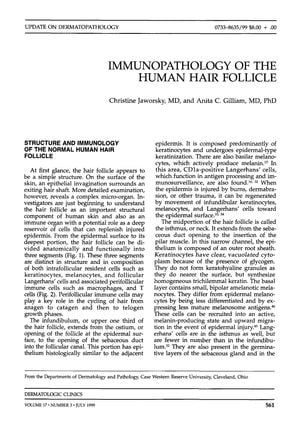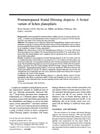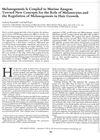IMMUNOPATHOLOGY OF THE HUMAN HAIR FOLLICLE
July 1999
in “
Dermatologic Clinics
”
hair follicle immune cells infundibulum isthmus alopecia areata lymphocyte infiltrate scarring alopecia lichen planopilaris discoid lupus erythematosus folliculitis epidermal replenishment autoimmune disorder inflammation hair follicle immune cells alopecia areata scarring alopecia lichen planopilaris discoid lupus erythematosus folliculitis autoimmune disorder inflammation

TLDR The document concludes that immune system abnormalities cause alopecia areata, but the exact process is still not completely understood.
The 1999 document examines the human hair follicle as a complex micro-organ with both structural and immune functions. It describes the follicle's three segments and their respective immune cell compositions, noting the infundibulum and isthmus as areas rich in immune cells. The document discusses the roles of various cell types in hair growth and immune responses, and the hair follicle's ability to contribute to epidermal replenishment post-injury. It also addresses conditions like folliculitis and systemic disease indicators. Specifically, the document focuses on alopecia areata, an autoimmune disorder characterized by a dense lymphocyte infiltrate around hair follicles and altered immunity, and scarring alopecia, which involves inflammation and permanent hair loss due to conditions like lichen planopilaris and discoid lupus erythematosus. The conclusion emphasizes that immunologic aberrations underlie alopecia areata, though its pathogenesis remains not fully understood, suggesting the need for further research into the mechanisms of hair growth and loss.



